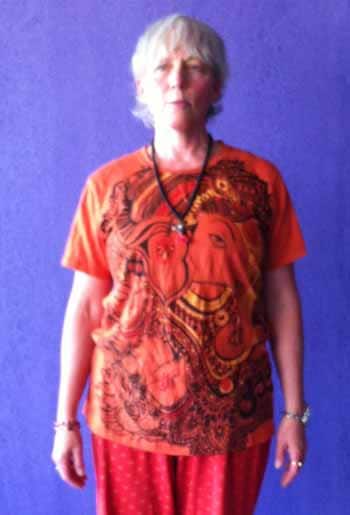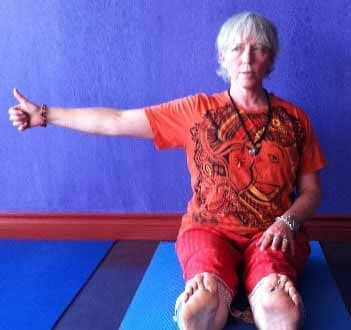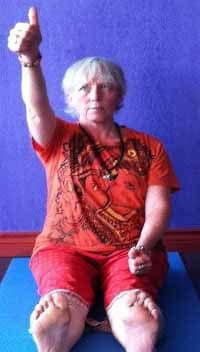Yoga for your eyes is important as we use our eyes throughout our days; for work and play. Keeping them focused and fixed for long periods of time on a computer screen, a highway, the television or reading a book causes strain. This also limits our peripheral vision; some of the muscles in the eyes become strong and others lose their integrity. If there is tension, then even a short period of reading can strain the eyes.
There are a wide variety of “asanas” for the eyes. The asanas help to neutralize eyestrain and teach us the correct use of all our eye muscles. When we gently and regularly move the eyes in all directions giving them a gentle massage, the six muscles that hold and allow the eyes to move in specific directions are strengthened. Even the effects of aging can be lessened with these simple movements. It is one of the easy stress management techniques that can be done anywhere. Below are a few examples of what you can practice.
Contraindications to Practicing Asanas for the Eyes: These exercises are not recommended for those with eye diseases or disorders such as glaucoma, trachoma, cataract, retinal detachment, retinal artery or vein thrombosis, iritis, keratitis or conjunctivitis. If you have these you should only perform yoga practices after consulting their eye specialist. When practicing, the eyes should be relaxed along with the facial muscles, eyebrows and eyelids. After each exercise the eyes should be closed for 30 seconds. The practice of palming may be performed at this time. Glasses or contacts should NOT be worn.
- Experiential Exercise – Eyes on the Sides of your Head –
Stand in Tadasana with arms at hips. Balance effort with relaxation as you press your feet into the floor and lift your chest. Keep your breath smooth and release any gripping in your shoulders and neck. Look straight ahead. After a few seconds, imagine that you have eyes on your temples that can see out to the sides. As you breathe, try to perceive what those eyes would be seeing. Don’t pull the images toward you; just let them passively seep in. If you feel a wave of relaxation come over you with this exercise, it’s likely you are holding tension in your eyes and facial muscles all day long.
- Palming – Benefits: Palming is a relaxing, alpha producing exercise in
 which heat produced is used to soothe the eyes. Palming relaxes and revitalizes the eye muscles and the entire nervous system. Benefits are enhanced if practiced in front of the rising or setting sun. Never look directly at the sun except for a few initial moments when it is just rising or setting.
which heat produced is used to soothe the eyes. Palming relaxes and revitalizes the eye muscles and the entire nervous system. Benefits are enhanced if practiced in front of the rising or setting sun. Never look directly at the sun except for a few initial moments when it is just rising or setting.
Usually this is done while seated. Your elbows should be supported (either on a table in front of you or on a thick cushion or two in your lap). It is recommended to remove all rings and watches and wash hands before beginning.
- Briskly rub your palms together until you feel warmth, charging them with energy.
- Cup your hands over your eyes so that your palms directly cover your closed eyelids (with no pressure on eyes).
- Heels of hands rest lightly on the cheekbones and fingers on the forehead. All light is excluded.
- Concentrate on relaxing your eyelids and releasing all tension held in them.
- Relax any undue tension in the muscles of the face, neck, shoulders or the rest of body.
- Recommended to hold for 4-5 minutes. Repeat 3-5 times in succession. This can form a daily practice.
- When time does not permit a longer practice, this can be done at any time. Even a few moments can keep the eyes refreshed and the mind relaxed.
- Visualize darkness and blackness. Pay attention to your breath. Notice how the body expands on the inhalation and shrinks on the exhalation. Go through all body parts from head to toe as you continue palming.
 Front and Sideways Viewing – Benefits: Improves coordination of medial and lateral muscles.
Front and Sideways Viewing – Benefits: Improves coordination of medial and lateral muscles.
In Dandasana, raise the R arm out to the side at shoulder level, keeping it straight and point the thumb upward. The thumb should just be in peripheral vision if looking straight ahead. The L arm is relaxed with the hand on the L thigh, and the thumb up. Without moving the head, focus the eyes on the following, one after the other. Inhale neutral position; exhale and look down at the L thumb; inhale and look up at the right thumb.
- Left thumb.
- Right thumb.
- Left thumb.
- Repeat this cycle 15-20 times. Close and rest eyes.
- Repeat on other side, holding the L arm out to the side and resting the R arm on the thigh.
- Close and rest eyes. Perform palming here for several repetitions when finished.
Modification: If the arm tires, rest on two stacked bolsters.
In Dandasana, make tight fists with thumb extended of both hands. Keeping the arms straight, slowing raise the R thumb while following the motion of the thumb with the eyes. When the thumb is raised to the maximum, slowly return it to the thigh, all the time focusing on the thumb without moving the head. Repeat with L arm. Inhale while raising eyes and exhale while lowering eyes. Repeat 5 times each side. Close and rest the eyes. Perform palming for several repetitions.
Helen Mikuska is a lead trainer for SOYA’s 200 hour yoga teacher training held in Calgary this July.
Please email info@harmonyyogapilatesstudio.ca




Recent Comments